 Image: IDG / Matthew Elliott
Image: IDG / Matthew Elliott
 At a glance
At a glance
Expert’s Rating
Pros
Big, bright 16-inch, 16:10 display with speedy 240Hz refresh rateGeForce RTX 3080 Ti is most potent GPU aroundPower duo of 12th-gen Core i9 CPU and massive 32GB of RAMUseful ports with both USB-A and -C ports with Thunderbolt 4 supportLow cost for a RTX 3080 Ti laptop
Cons
Lower TDP RTX 3080 Ti can’t keep pace with higher-wattage unitsSo-so speakersStiff touchpadBack vents make it uncomfortable to carry the laptop
Our Verdict
The Acer Predator Triton 500 SE delivers the goods for gamers but also supplies an understated design and 16-inch, 16:10 display that extends its value and versatility.
Price When Reviewed
$2,999.99
Best Prices Today: Acer Predator Triton 500 SE
RetailerPrice
The Acer Predator Triton 500 SE is a thin machine with a lean price, which makes it stand out among the sea of gaming laptops. Our test model packs an Nvidia GeForce RTX 3080 Ti GPU and a 12th-gen Core i9 CPU along with a generous 32GB of RAM and a 1TB SSD for the reasonable sum of $2,999.99. Laptops with such a pairing are usually closer to $4,000 with many exceeding that mark. The Triton features a RTX 3080 Ti with a lower TGP than some higher-priced laptops with the same GPU, but it still delivers an excellent bang for the buck if not the best frame rates you’ll see from a 3080 Ti laptop. When shopping for a gaming laptop, buyers must look beyond a component’s model name and number and dig into the specs to get the full picture.
Like the previous model we reviewed, it features a roomy 16-inch display with a tall, 16:10 aspect ratio and a crisp 2560 x 1600 resolution. The 16:10 display provides more room vertically than a wider 16:9 screen and makes the system more useful as a general use laptop than purely a gaming rig. Despite its added versatility, it’s an even more capable gaming laptop than its predecessor because Acer has made the display even faster by pushing the refresh rate to a blazing 240Hz. The Acer Predator Triton 500 SE not only provides great value for gamers, but it also makes a compelling case for general use shoppers looking for a do-it-all laptop for work that can pull double duty for gaming when the workday is done.
Acer Predator Triton 500 SE specifications
Our Acer Predator Triton 500 SE test system costs $2,999.99 and features the following specs:
CPU: 14-core Intel Core i9-12900HMemory: 32GB DDR5 4800Graphics: Nvidia GeForce RTX 3080 Ti @ 115 Watt TGPStorage: 1TB PCIe NVMe M.2 SSDDisplay: 16.0 inch,16:10, 2560 x 1600 resolution with 240Hz refresh rateWebcam: 1080pPorts: Left side: Gigabit ethernet, USB-A 3.2 Gen 2, USB-C (with Thunderbolt 4), headphone jack. Right side: SD card reader, USB-A 3.2 Gen 2, USB-C (with Thunderbolt 4), HDMI 2.1Networking: Wi-Fi 6E, Bluetooth 5.2Biometrics: Fingerprint readerBattery capacity: 99.9 Watt-hoursDimensions: 14.1 x 10.3 x 0.78 inchesMeasured weight: 5.07 pounds (laptop), 1.66 pounds (AC adapter)
Acer offers a mix of 11th- and 12th-gen Intel Core processors with the Predator Triton 500 SE line along with GPUs ranging from the RTX 3060 to the RTX 3080 Ti. All models feature the same 16-inch display with a 16:10 aspect ratio and 2560 x 1600 resolution, but some have a refresh rate of 165Hz while others are faster at 240Hz. Both Windows 10 and 11 are offered. Our model features the latter. The line starts at $1,750 for a system with RTX 3060 graphics and an 11th-gen Core i7 CPU powering a 165Hz panel. Our $3,000 review system sits near the top of the line. The only model that’s pricier is a $3,500 model that doubles the SSD to 2TB.
Bright, fast display
The Predator Triton 500 SE may have an aggressive monitor — one that mixes the name of an animal that preys on others with a Greek god of the sea — but it does not have the look of many gaming laptops. It features an understated, dark gray aluminum enclosure that would not look out of place in an office. There’s a small Acer Predator logo on the top of the lid and another on the bottom bezel below the display. The logos are neither oversized nor do they glow or pulse with LED lighting. There’s also a Turbo button above the keyboard tucked in the speaker grille that’s easily overlooked; it overclocks the CPU and GPU and revs up the cooling fans.
The biggest clue that this is a gaming laptop are the large vents on the laptop’s back edge and the smaller vents that occupy the back third of each side edge. The exhaust vents run the length of the back edge and feature some strips of material to protect the vents and add a dash of style. These strips feature sharp corners, which make the laptop a bit uncomfortable to carry around. Softer vent covers next time, please, Acer.
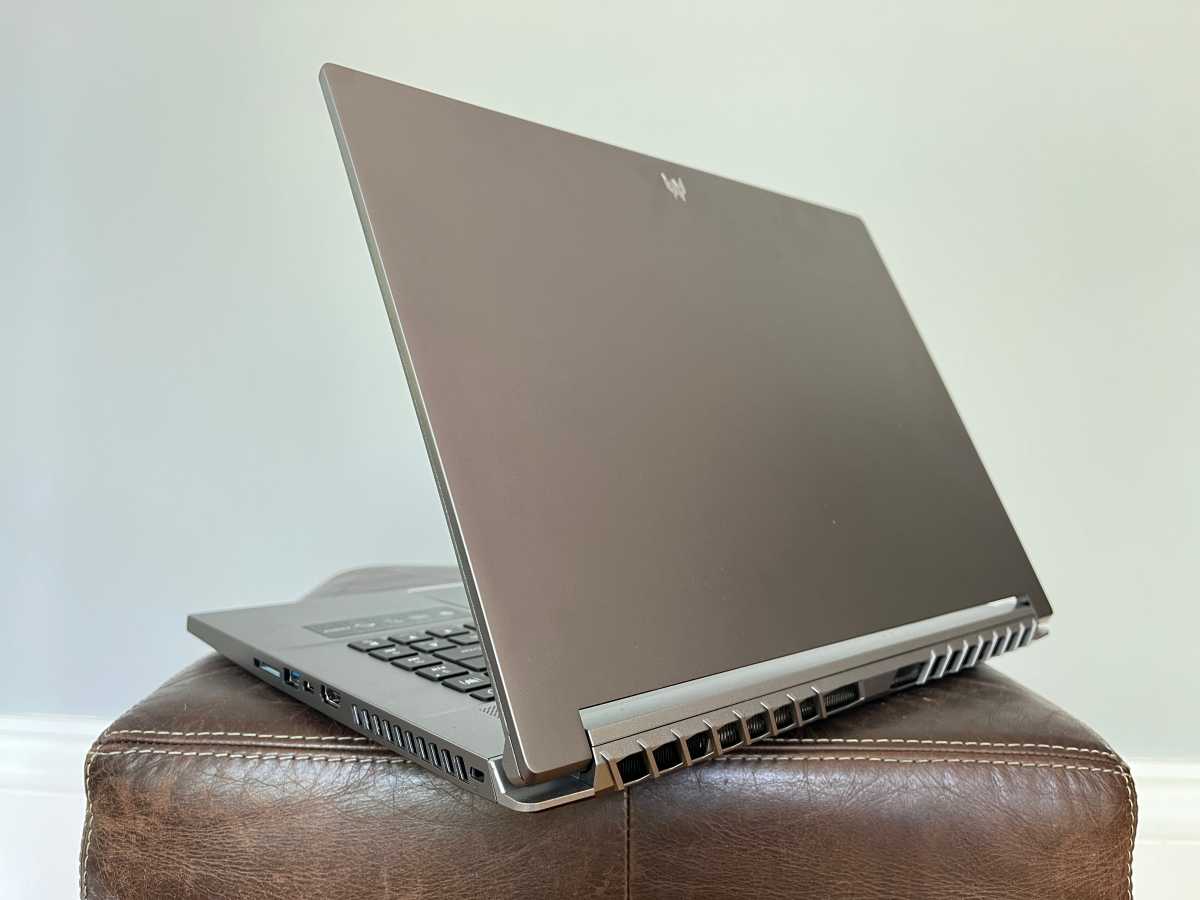
IDG / Matthew Elliott
IDG / Matthew Elliott
IDG / Matthew Elliott
Part of the discomfort in toting the Predator Triton 500 SE around is the fact that it’s a hefty laptop, as gaming laptops tend to be. It’s not bulky at less than an inch thick, but it weighs just over five pounds. By comparison, the HP Spectre x360 16 is another laptop with a 16-inch, 16:10 display and is more than a half-pound lighter at 4.45 pounds. Still, it’s much lighter than a 17.3-inch model like the MSI GE76 Raider that tips the scales at 6.4 pounds.
A 16-inch display with a 16:10 aspect ratio sits in the sweet spot between 15.6-inch and 17.3-inch models with wider 16:9 ratios. The laptop’s size and weight are closer to the former while the display feels as roomy as the latter. Not all games will fit the 16:10 aspect ratio and will leave you with black bars on the top and bottom of the display. You likely won’t notice after a short while and the added benefit of the taller display can be felt during regular Windows use. You can see more lines on the screen of a web page or Word doc, which means less scrolling.

IDG / Matthew Elliott
IDG / Matthew Elliott
IDG / Matthew Elliott
In addition to its generous dimensions, the display is also fast and bright. It features a blazing 240Hz refresh rate and is rated for 500 nits of brightness. To match the display’s refresh rate to the frame rates in games to avoid screen tearing, the display features Nvidia’s G-Sync. Colors looked accurate and vivid in games and during general Windows use. The matte finish on the display also does an admirable job in combating glare and reflections. All in all, the 16-inch, 16:10 display provides ample room to multitask in Windows and is big enough for gaming without being forced to carry around a big and bulky 17.3-inch laptop.
A 1080p webcam sits above the display that produces crisp, well-balanced video that’s clearly superior to a 720p camera. It lacks a physical privacy cover, but a small LED glows green to alert you that the camera is on.
Comfortable keyboard and useful ports
We will get to the loaded component lineup in the next section and the Predator Triton 500 SE’s performance, but first let’s cover how it keeps its high-powered parts cool. The laptop employs three cooling fans, which you can control with the preinstalled PredatorSense app. You can also kick them into high gear by pressing the aforementioned Turbo button above the keyboard. Under the laptop’s default settings, the fans rev up only under heavy loads — while gaming and running our graphic benchmarks. Thankfully, you can engage in serious multitasking in Windows and stream HD video without getting blasted by fan noise.
The laptop’s speakers fire upward from above the keyboard, but will struggle to be heard over the fans when gaming. Given the generous dimensions of the laptop, we had higher hopes for its audio output. The sound suffices for watching YouTube and Netflix but lacks the bass response needed for music playback. And gamers will want to use headphones for improved sound and to drown out the fan noise that’s frequently present when gaming.
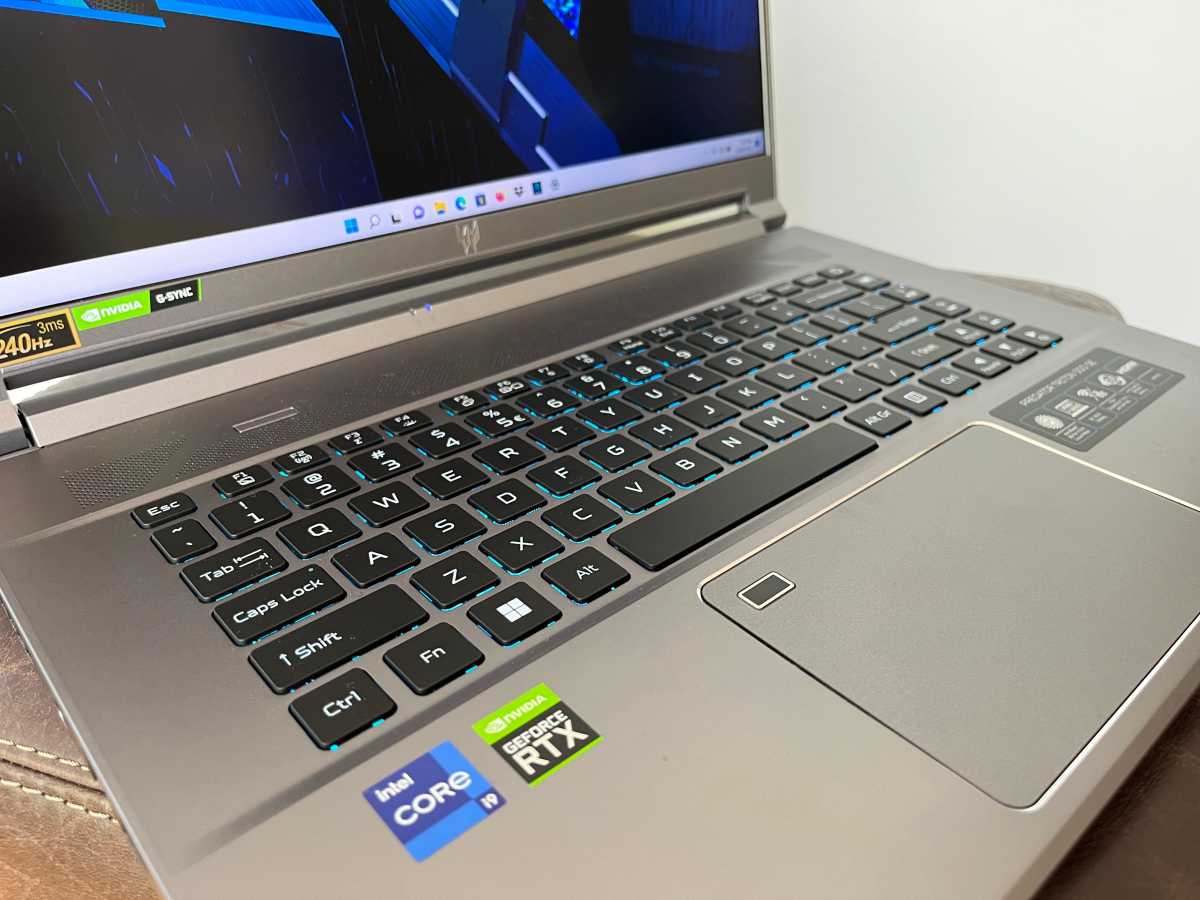
IDG / Matthew Elliott
IDG / Matthew Elliott
IDG / Matthew Elliott
The keyboard is excellent. The keys feel springy and firm. Acer didn’t attempt to squeeze in a dedicated number pad, and the Predator Triton 500 SE is better for it. The keys are well spaced and nothing feels cramped. You even get four full-sized arrow keys. The right-most column of keys offers useful volume and media-playback controls plus the PredatorSense key for managing the cooling system, overclocking, and the keyboard’s three-zone RGB backlighting.
The touchpad features a glass surface for smooth mousing, but it offers a firm click that will give your finger a workout. As much as I liked gliding across its smooth surface, I quickly grew tired of the firm clicks and ended up plugging in a mouse. One other note about the touchpad: it features a fingerprint reader for easy, secure logins.
There’s a USB Type-A port on either side of the laptop, which will make both right- and left-handed mousers happy to be able to connect their mouse to their preferred side. There’s also a USB Type-C Thunderbolt 4 port on either side of the display for greater transfer speeds and versatility. The headphone jack sits on the left side while you get an HDMI 2.1 port on the right. There’s also a full-sized SD card reader on the right side.
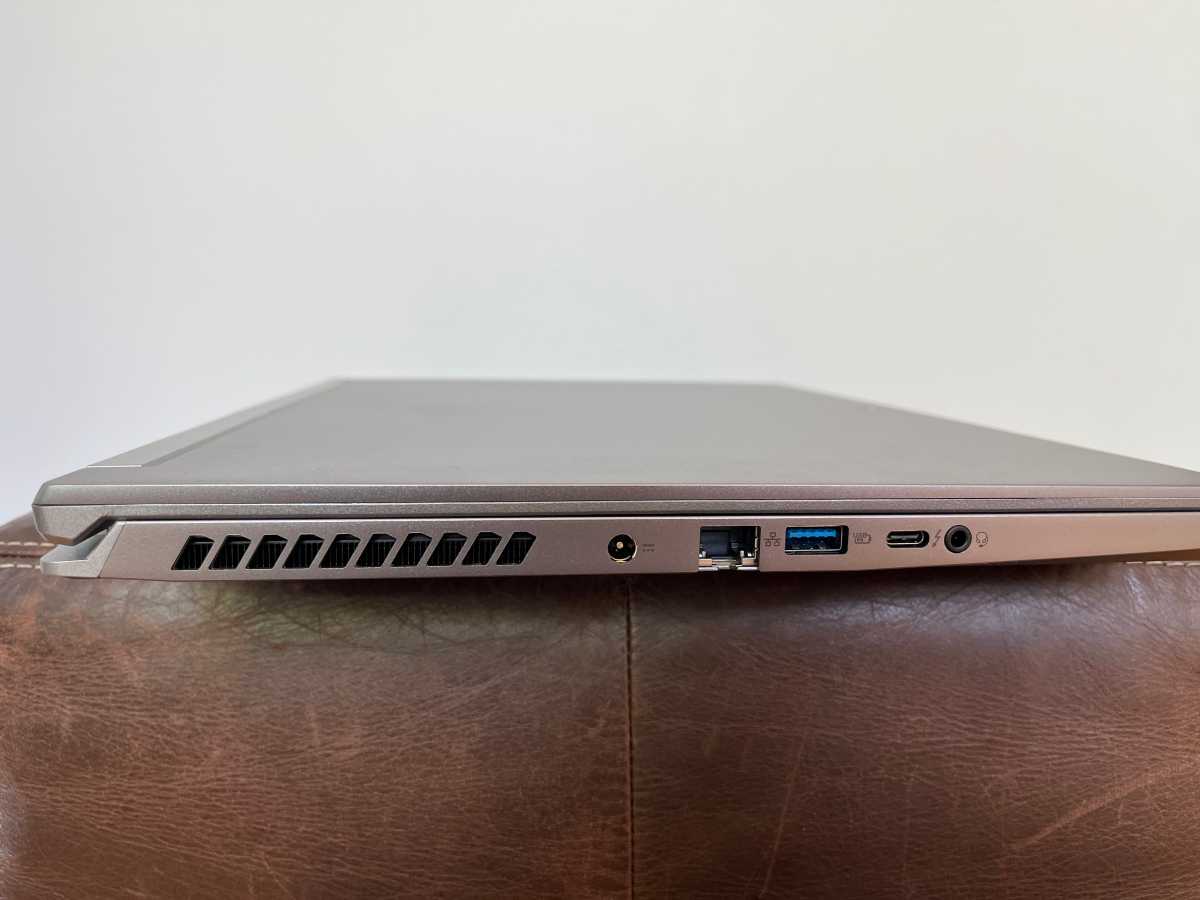
IDG / Matthew Elliott
IDG / Matthew Elliott
IDG / Matthew Elliott
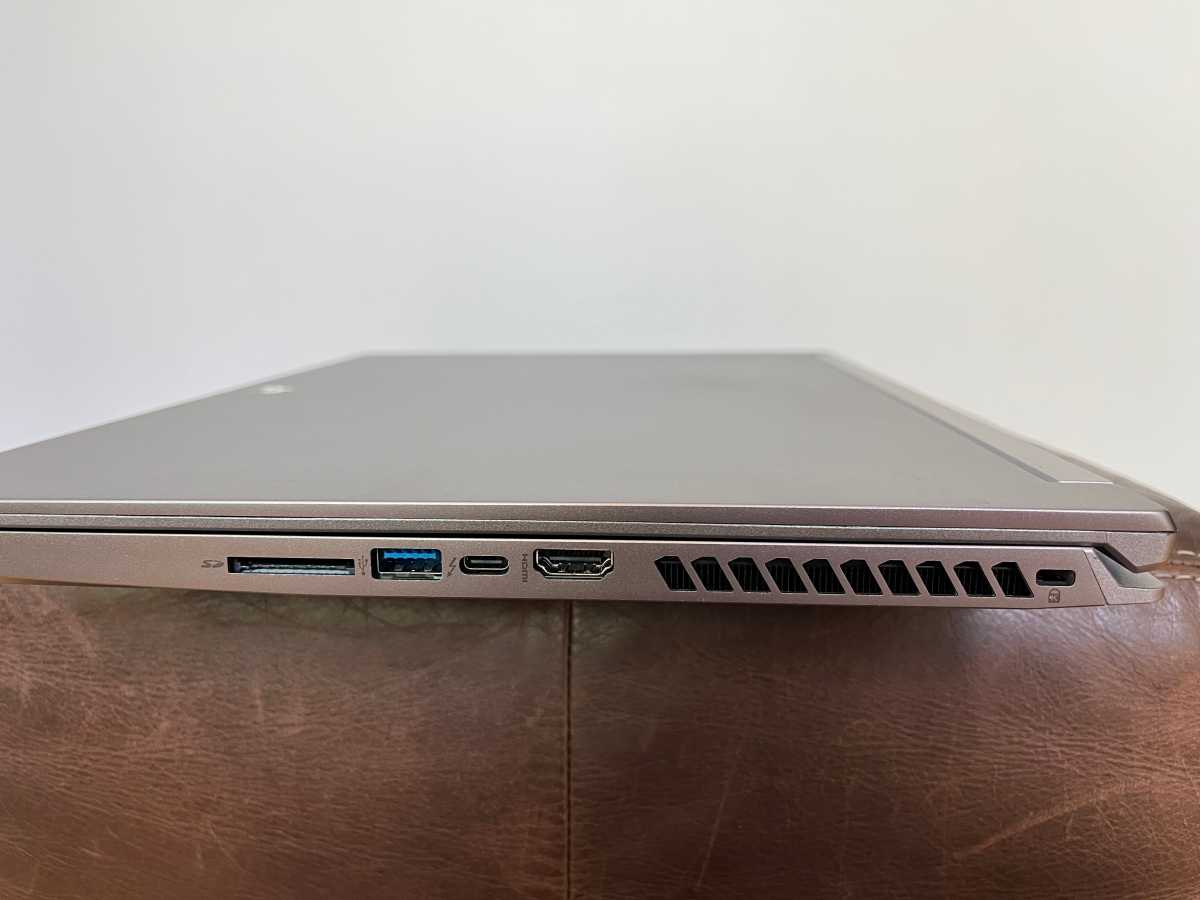
IDG / Matthew Elliott
IDG / Matthew Elliott
IDG / Matthew Elliott
For networking, there’s a Gigabit Ethernet jack and the system also supports Wi-Fi 6E and Bluetooth 5.2 — all the latest and speediest standards.
Performance
Now we get to the good stuff. Beneath the unassuming exterior of our Acer Predator Triton 500 SE is a murderer’s row of high-end parts highlighted by RTX 3080 Ti graphics and a 12th-gen Intel Core i9-12900H processor. This new Core i9 chip features 14 cores (six performance cores and eight efficiency core) and 20 threads and can reach a frequency as high as 5GHz. The laptop also delivers a boatload of RAM at 32GB and a spacious 1TB SSD.
The RTX 3080 Ti is currently the top dog among Nvidia’s RTX 30 series for laptops, but the Triton’s 3080 Ti isn’t the highest-powered 3080 Ti. It has a TDP of 115 watts, which is considerably lower than other 3080 Ti-based laptops. The Razer Blade 17 features a 165-watt 3080 Ti and the MSI GE76 Raider has a 175-watt 3080 Ti. Rounding out the charts are two RTX 3080 laptops — the Asus ROG Zephyrus S17 and the Razer Blade 14 — and the RTX 3070-based Adata XPG 15 KC.
Our first benchmark is PCMark 10, which measures performance on everyday computing work including office productivity tasks, web browsing, and video chats. The Predator Triton 500 SE did quite well on PCMark 10. We’ve not seen many laptops post a score north of 7,000 on this test, but it was easily outpaced by two other 12th-gen Intel-based laptops, the MSI GE76 Raider with a similar 12th-gen Core i9 chip and the Razer Blade 17 with a 12th-gen Core i7 chip that also features 14 cores.
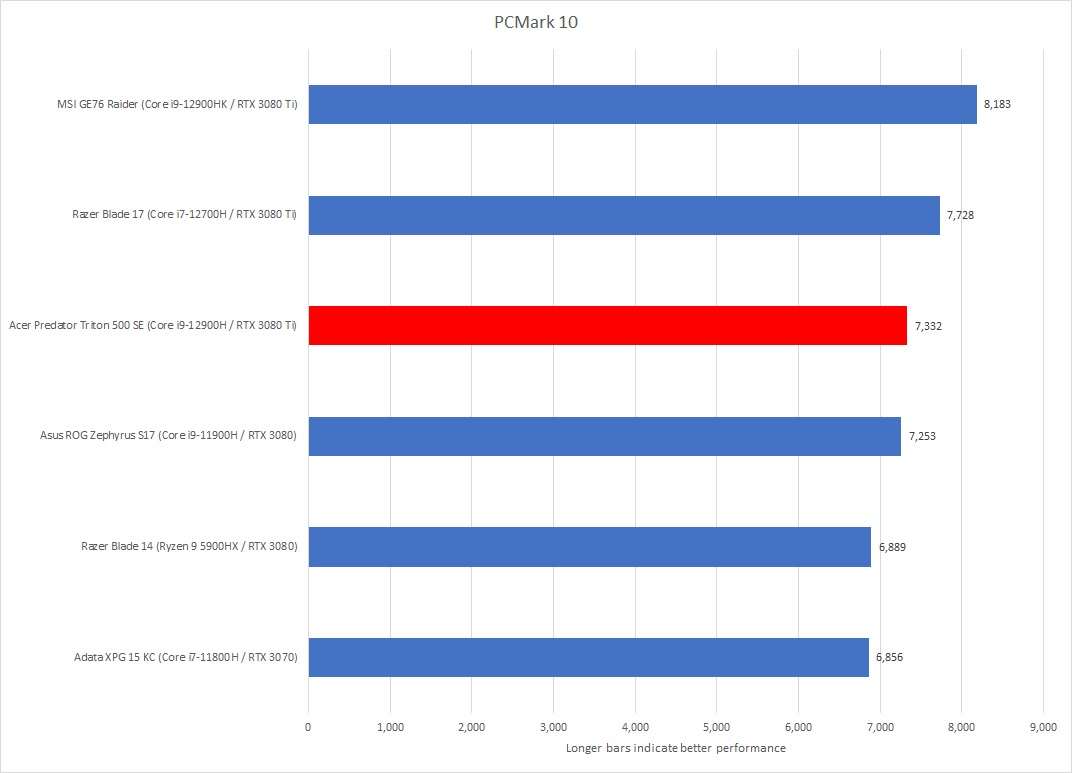
IDG / Matthew Elliott
IDG / Matthew Elliott
IDG / Matthew Elliott
Our HandBrake benchmark tests how a laptop can handle crushing CPU loads over a lengthy period—in this case, transcoding a 30GB MKV file to a format suitable for Android tablets. The Predator Triton 500 SE and MSI GE76 Raider led the way, indicating their ability to handle media editing in addition to 3D games.
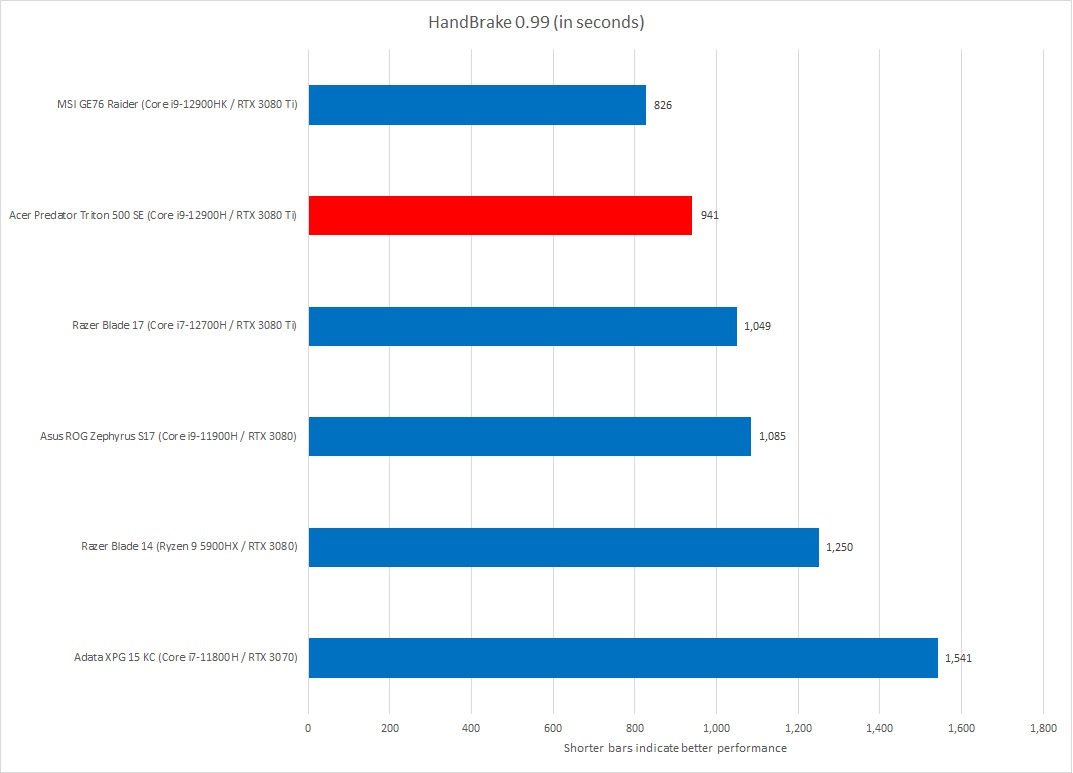
IDG / Matthew Elliott
IDG / Matthew Elliott
IDG / Matthew Elliott
Next up is Cinebench, another CPU-intensive test but one that renders a complex 2D scene over a short period of time. The Triton again turned in a strong showing and again finished second but this time behind the Razer Blade 17 on both the multi-thread and single-thread tests.
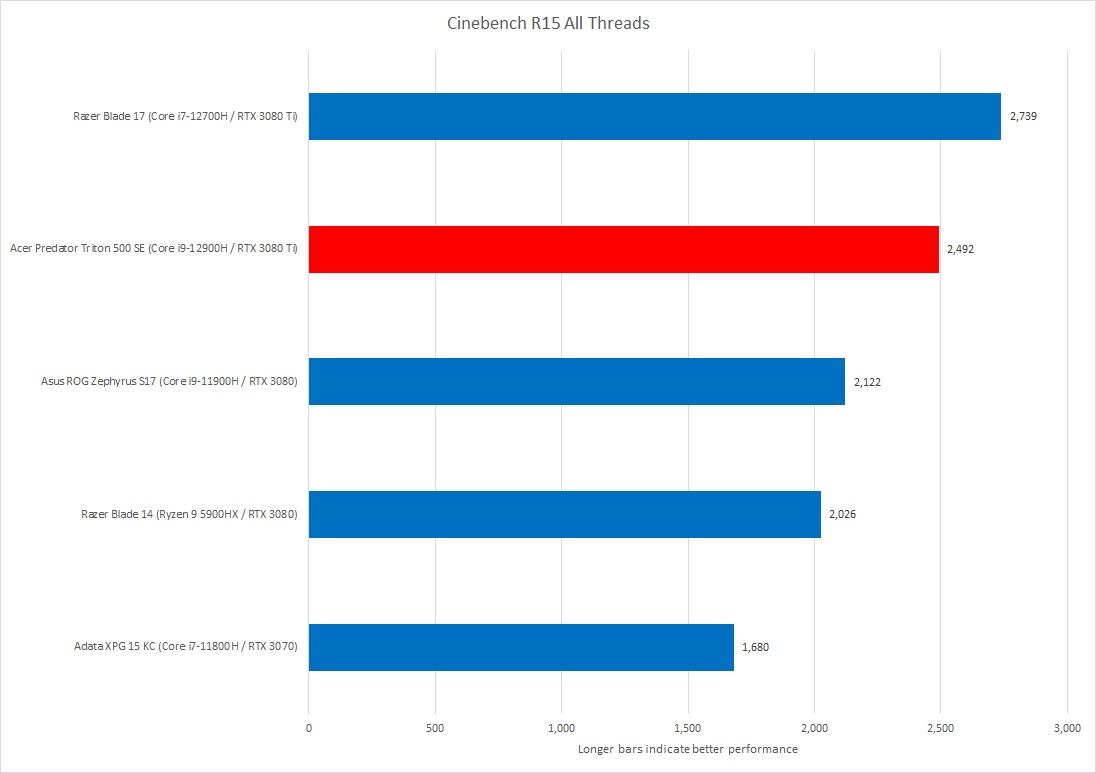
IDG / Matthew Elliott
IDG / Matthew Elliott
IDG / Matthew Elliott
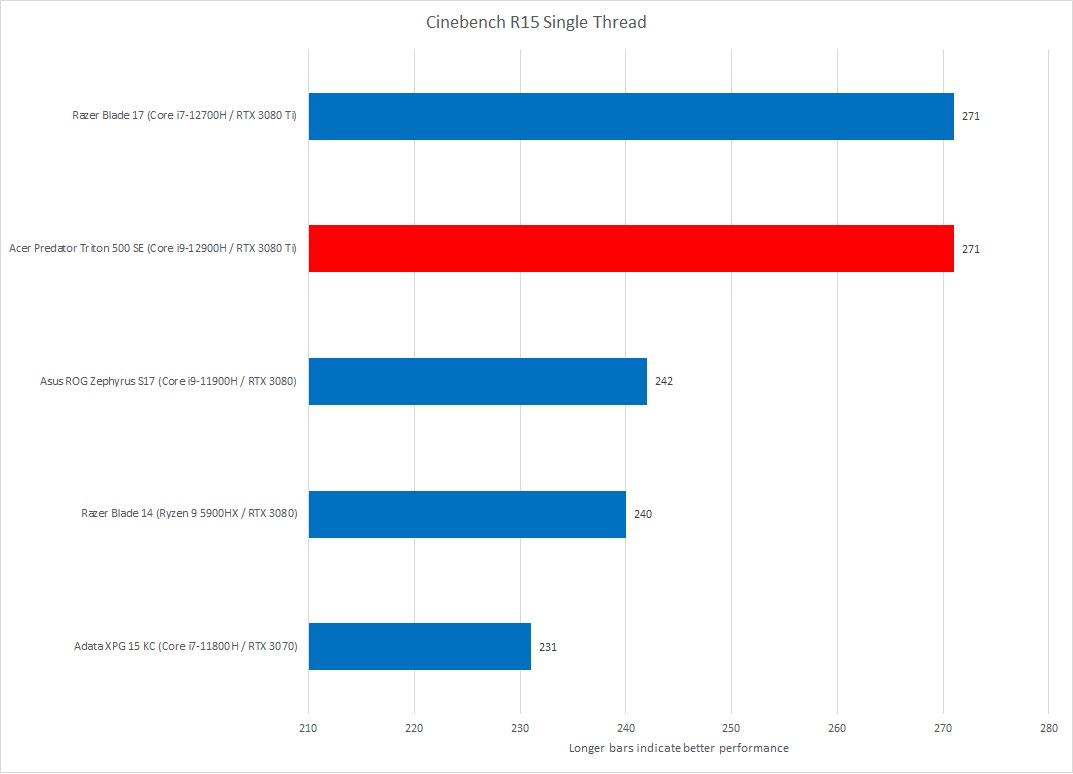
IDG / Matthew Elliott
IDG / Matthew Elliott
IDG / Matthew Elliott
The Predator Triton 500 SE had its first stumble on 3DMark’s Time Spy and Port Royal tests, where the system fell behind the RTX 3080-based Asus ROG Zephyrus S17 while the other two 3080 Ti laptops led the way. What’s interesting is that the Zephyrus’ GPU has a TPD of 140 watts, higher than that of the Triton’s 115-watt 3080 Ti. A higher TDP doesn’t always equate to higher performance, but in this case it appears that it helped the Zephyrus top the Triton.
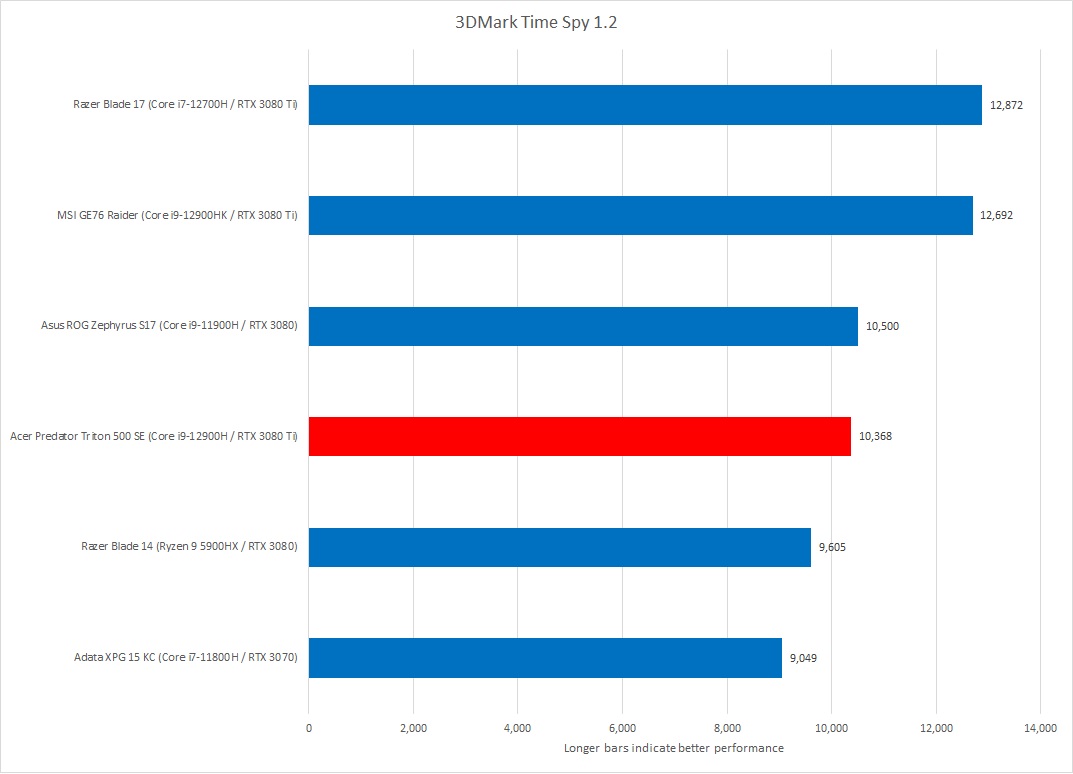
IDG / Matthew Elliott
IDG / Matthew Elliott
IDG / Matthew Elliott
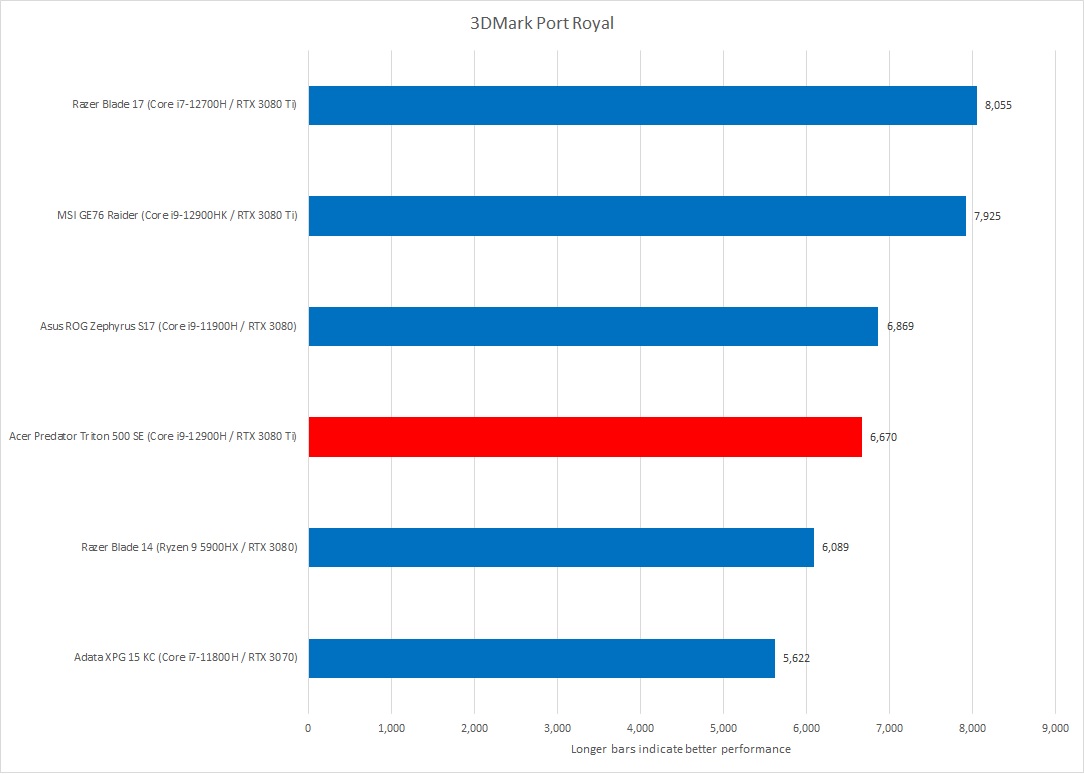
IDG / Matthew Elliott
IDG / Matthew Elliott
IDG / Matthew Elliott
For real-world game testing, we used Rise of the Tomb Raider at 1920×1080 resolution at the Very High quality preset, the newer Shadow of the Tomb Raider at 1920×1080 resolution at the Highest quality preset, and Metro Exodus at 1920×1080 at the Extreme quality preset. On both Rise of the Tomb Raider and Shadow of the Tomb Raider, the Triton turned in very playable framerates that were more than double the minimum 60 fps needed for smooth gameplay. On the more demanding Metro Exodus, however, the laptop managed only 45 fps.
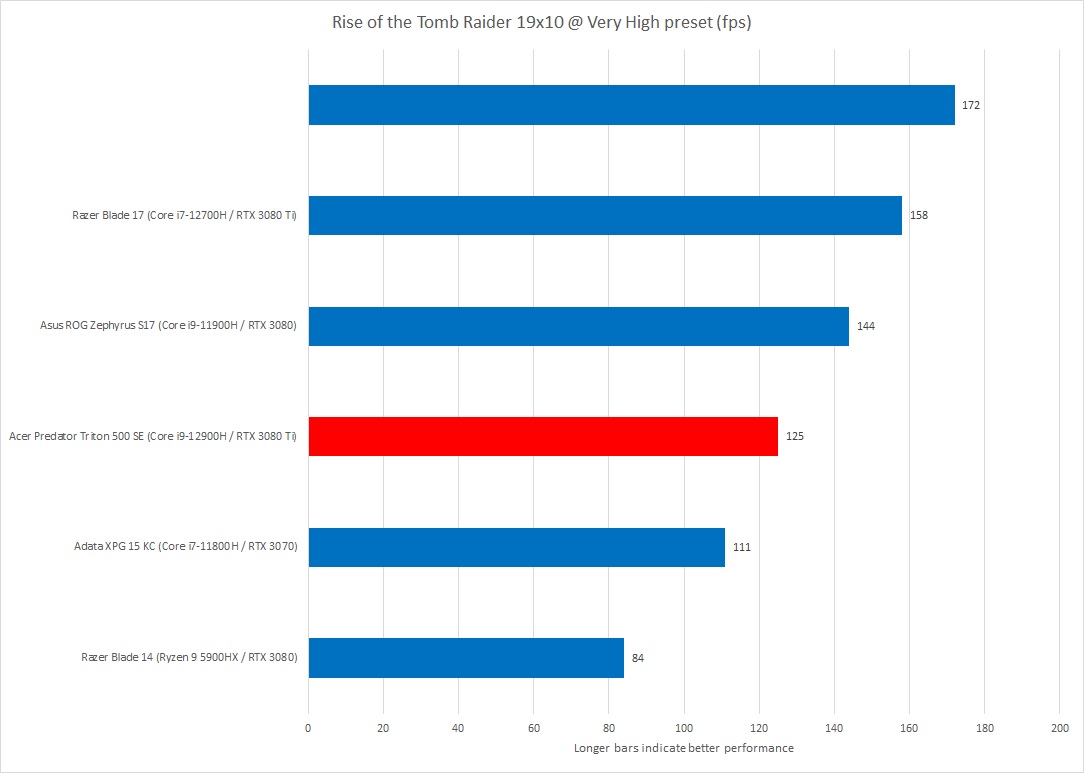
IDG / Matthew Elliott
IDG / Matthew Elliott
IDG / Matthew Elliott
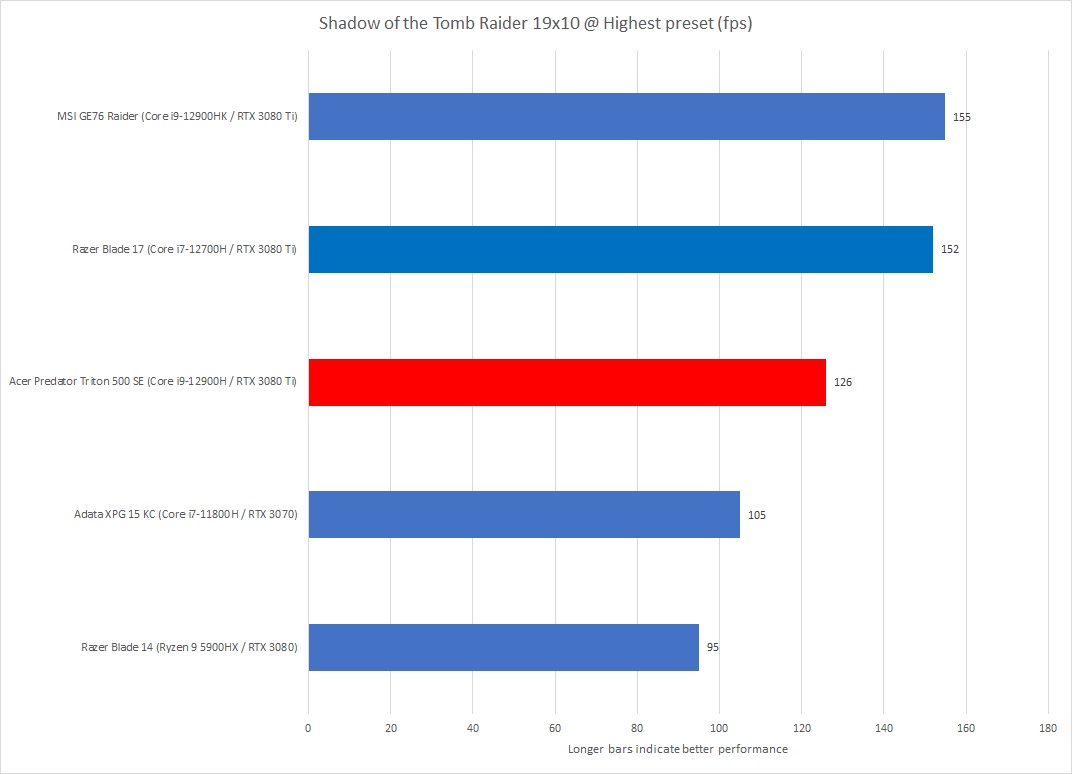
IDG / Matthew Elliott
IDG / Matthew Elliott
IDG / Matthew Elliott
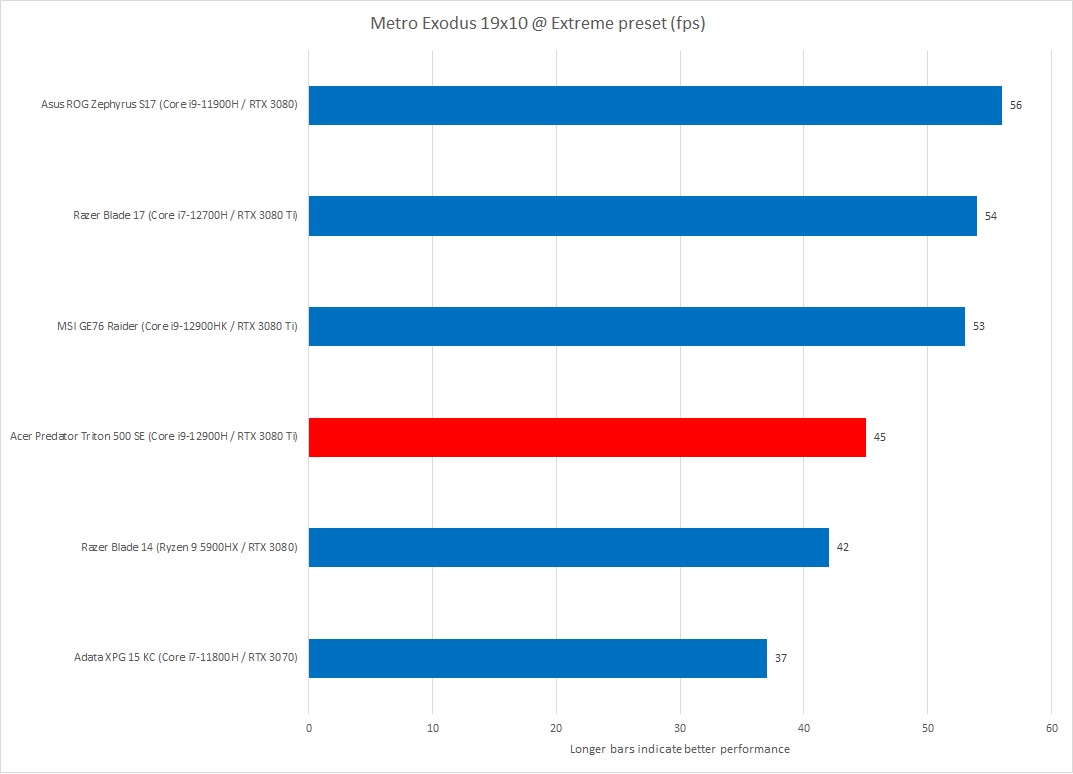
IDG / Matthew Elliott
IDG / Matthew Elliott
IDG / Matthew Elliott
Battery life
To test a laptop’s battery life, we loop a 4K video using Windows 11’s Movies & TV app with the machine set to Airplane mode and earbuds plugged in. We set the screen brightness at a relatively bright 250 to 260 nits, which is a good brightness for watching a movie in an office with the lights on. With its large, high-resolution display, the Predator Triton 500 SE lasted a respectable six and a half hours.

IDG / Matthew Elliott
IDG / Matthew Elliott
IDG / Matthew Elliott
Conclusion
It’s true that the Acer Predator Triton 500 SE is a step behind competing gaming laptops with higher-wattage RTX 3080 Ti GPUs, namely the MSI GE76 Raider and Razer Blade 17. These competing models, however, cost $1,000 or more than the Predator Triton 500 SE, making it a great value at its price of $3,000. The Triton extends its value and versatility by using a 16-inch, 16:10 display. The MSI and Razer models feature larger, 17.3-inch displays that make them more likely to stay anchored to a desk than as an everyday laptop. While the Triton is certainly not the most compact laptop, it remains fairly portable while providing ample screen real estate that won’t cramp your style or multitasking ways. It’s overqualified to be a productivity laptop that moonlights as a gaming system, but a strong argument can be made that it delivers great value as a gaming laptop that can also be used at school or in the office.
Best Prices Today: Acer Predator Triton 500 SE
RetailerPrice
Author: Matt Elliott
Recent stories by Matt Elliott:
MSI Prestige 16 Studio review: A mini-LED laptop for lessDell XPS 17 9730 review: No OLED for content creatorsLenovo Legion Pro 7i review: Blazing performance, good price


